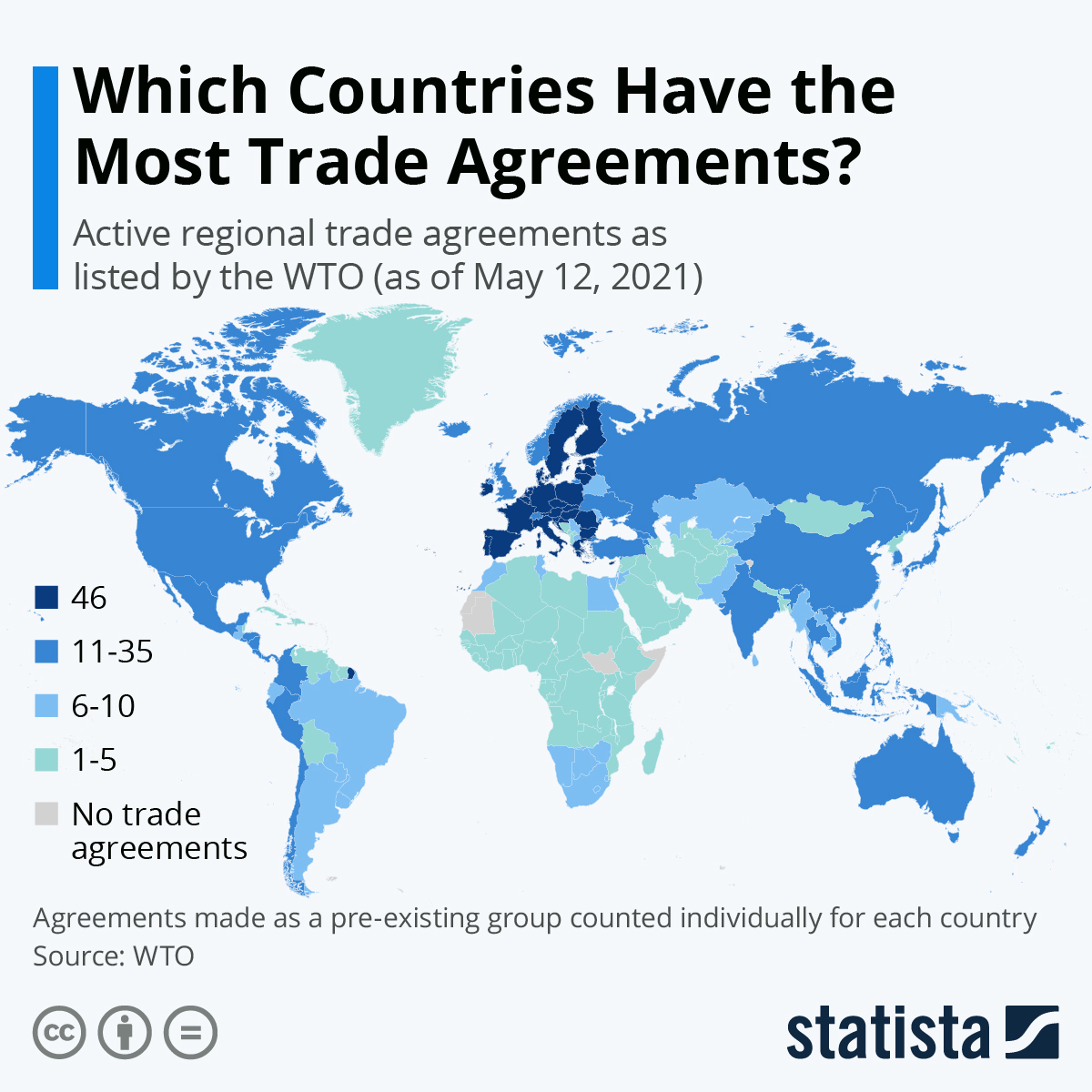Catalina Espinosa
Research expert covering society, economy, and politics for Europe and the EU


Detailed statistics
EU international trade as a share of GDP 1970-2022

Detailed statistics
EU share of world exports and imports 2002-2023

Detailed statistics
Share of EU exports by trading partner 2002-2023

Total value of Extra-EU trade, exports, imports, and trade balance in goods 2023
Total value of the European's Union's trade, exports, imports, and trade balance in goods with its largest non-EU trading partners in 2023, by country

EU share of world exports and imports 2002-2023
Annual share of world goods imports and exports of the European Union from 2002 to 2023

EU international trade as a share of GDP 1970-2022
Annual international trade as a share of gross domestic product for the European Union from 1970 to 2022

Terms of trade for EU & Eurozone 1995-2022
Annual terms of trade for the European Union and the Eurozone from 1995 to 2022 (where 0 indicates neutrality)

EU: export/import ratio by product groups 2023
Annual export/import ratio of goods from the European Union with the rest of the world by product group in 2023 (where imports = 1)

EU: regional trade agreements (RTAs) from 1994 to 2024
Annual number of Regional Trade Agreements (RTAs) coming into force and cumulative number of RTAs in force for the European Union from 1994 to 2024

EU: annual trade balance of goods 2002-2023
Annual international trade balance in goods of the European Union with the rest of world from 2002 to 2023 (in millions of Euro)

EU trade balance of services 2013-2022
Annual trade balance of services for the European Union with all non-EU countries from 2013 to 2021 (in millions of Euro)

EU: goods trade balance with rest of world by member state 2023
Annual international trade balance in goods of the European Union with the rest of world broken down by EU member states in 2023 (in millions of Euro)

International Trade of the EU: external trade balance of the EU by product 2002-2023
Annual external goods trade balance of goods for the European Union by product group from 2002 to 2023 (in millions of Euro)

EU: share of extra-EU exports by member state 2002-2023
Annual share of the exports of the European Union to the rest of world from 2002 to 2023, by member state

Share of EU exports by trading partner 2002-2023
Annual share of exports from the European Union to non-EU countries by trading partner from 2002 to 2023

EU services exports to the rest of world by product group 2013-2021
Annual services exports of the European Union to the rest of world by product category from 2013 to 2021 (in millions of Euro)

International Trade of the EU: world goods exports share by product group 2002-2023
Annual share of world exports exported by the European Union broken down by product groups from 2002 to 2023

International Trade of the EU: transport methods used for extra-EU exports 2000-2023
Annual share of European Union goods exports to countries outside the EU by transportation method from 2000 to 2023

International Trade of the EU: share of exports by currency invoiced 2010-2022
Share of goods exports from the European Union to the rest of world by currency used from 2010 to 2022

International Trade of the EU: share of extra-EU imports by member state 2002-2023
Annual share of the imports into the European Union from the rest of world from 2002 to 2023, by receiving country

International Trade of the EU: largest goods import partners by trade share 2002-2023
Annual share of EU goods imports from non-EU countries by trade partner from 2002 to 2023

EU services imports by product group 2013-2021
Annual services imports of the European Union from the rest of world broken down by product category from 2013 to 2021 (in millions of Euro)

International Trade of the EU: world goods imports share by product group 2002-2023
Annual share of world imports imported by the European Union broken down by product groups from 2002 to 2023

EU: transport methods used for extra-EU imports 2000-2023
Annual share of European Union goods imports from countries outside of the EU by transportation method from 2000 to 2023

EU external imports by currency 2010-2022
Shares of goods imports from the rest of world to the European Union by currency in which the trade was invoiced in from 2010 to 2022

Goods trade balance of the European Union with the United States of America 2012-2022
Monthly goods trade balance of the European Union with the United States of America from 2012 to 2022

Trade balance of the European Union with China 2013-2023
Trade balance of the European Union with China from 2013 to 2023 (in billion euros)

United Kingdom (UK) trade balance with European Union 1999-2023
Trade balance of the United Kingdom (UK) with the European Union in goods and services from 1999 to 2023 (in million GBP)

EU Enlargement: Goods trade balance of the EU with accession countries 2022
Goods trade balance of the European Union with EU candidate countries in 2022 (in millions of Euros)

EU and Mercosur: foreign trade balance 2010-2023
Foreign trade balance between the European Union and Mercosur from 2010 to 2023 (in billion euros)

Trade balance of total goods between Vietnam and the EU 2011-2023
Trade balance of total goods between Vietnam and the European Union from 2011 to 2023 (in billion euros)

Trade balance of Ukraine with the EU 2020-2023
Balance of trade between Ukraine and the European Union (EU) from 2020 to 2023 (in million U.S. dollars)

EU merchandise trade value with Russia 2020-2023, by flow
Export and import value and trade balance of the European Union (EU) with Russia from 2020 to 2023 (in billion euros)


Mon - Fri, 9am - 6pm (EST)
Mon - Fri, 9am - 5pm (SGT)
Mon - Fri, 10:00am - 6:00pm (JST)
Mon - Fri, 9:30am - 5pm (GMT)
Mon - Fri, 9am - 6pm (EST)